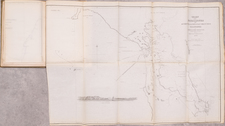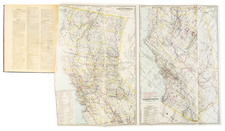Forsyth, James W. Report of Colonel James W. Forsyth: Enclosing maps, itinerary and diary of the march made under his command by the headquarters and troops " C, " " D, " " G " and " M " 7th Cavalry. From Fort Meade, Dakota to Fort Riley, Kansas, From July 25th, 1887 to September 8th, 1887 . . .
Oblong Folio. Marbled boards. Title page, 7 pp report overview, pp 8-50 (Itinerary and Diary)., 38 single page maps, number 1-9 and 1-29.
Maps and Itinerary/Diary pages printed on recto only, facing each other.
The book is endorsed on page 7 by Forsyth, in the hand of his Adjutant, and includes red editorial corrections, including a note on map 10 (second map No. 1).
The March
The War Department, realizing that Indian depredations were now rare occurrences and believing that the Sioux Nation had accepted its fate of life on the reservations in the Dakota Territory, began consolidating regiments at larger posts and deactivating smaller ones. A portion of the 7th Cavalry was ordered to Fort Riley, Kansas, at the end of June 1887. On the 28th Colonel James W. Forsyth led the field and staff, band and troops C, D, G, and M on a 736 mile march by horseback that took more than five weeks to complete. The regiment traveled with all its personnel, equipment, supplies, and forage, and also transported the troopers’ families and personal belongings.
On the march to Fort Riley, Major Whitside commanded his battalion, which consisted of the four line troops. Forsyth and Whitside were the only field grade officers who relocated to Fort Riley. Lieutenant Colonel Joseph C. Tilford took command of the remainder of the regiment at Fort Meade along with Majors John W. Bacon and Daniel Madden. By the following summer, the entire regiment had departed the Dakota Territory and taken up station at Fort Riley, Kansas, and Fort Sill, Indian Territory.
Description
A remarkable object, being the published report, itinerary, diary and maps of Forsyth's march from Fort Meade to Fort Riley. The maps provide a detailed topographical image of the entire route, with text only entries for non-travel days. Forstyh's march was undertaken following his appointment as commander of Fort Riley, Kansas.
The maps in the itinerary were made by Captain Henry Jackson, 7th Cavalry and 2nd Lieutenant George H. Cameron, 7th Cavalry. The Diary is by 2nd Lieutenant James D. Mann, 7th Cavalry, as acting Regimental Adjutant.
From the October 13, 1888 edition of the United States Army and Navy Journal Gazetter of the Regular and Volunteer Forces Volume XXVI - 1888-'89 at page 131.
THE very interesting report of Colonel James W. Forsyth, 7th Cavalry, with the maps, observations and diary of the march made under his command by the headquarters and Troops C, D, G and M, 7th Cavalry, from Fort Meade, Dak... to Fort Riley, Kas., from July 25, 1887, to Sept. 8, 1887, has been issued in a Volume with flexible covers, the maps, which are on the scale of two miles to one inch, requiring a page of 10%x14 in. The maps and notes for the itinerary were made by Captain Henry Jackson, 7th Cavalry, except the notes for that portion from Fort Meade to Fort Robinson, which was kept by 2d Lieutenant Geo. H. Cameron, 7th Cavalry. The official diary for the entire march was kept by 2d Lieutenant James D. Mann, 7th Cavalry, who was acting regimental adjutant. The actual cost, not including subsistence, of transporting the command was $2.941.44, viz., oats, $1,942.47; corn, $126.12; hay, $625.92; wood, $145.18; bridge tolls, $35.25; camping grounds, $66.50. The distance travelled as shown by two odometres, verified by official distances while travelling near the railroads, was 728.96 miles, a mean average of 4.11 miles, the maximum being 4.91 the minimum 3.20, the gait being the walk. Troops alternated daily in marching at the head of the column. The second day out the horses were stampeded, while they were (4.30 P.M.) on the picket line, by a furious hail storm, and several officers and men, while endeavoring to control them, were bruised by hail stones. All the horses were recov ered before 8.15 P.M.
James William Forsyth
James William Forsyth (1834 – 1906) was a U.S. Army officer and general. He was primarily a Union staff officer during the American Civil War and cavalry regimental commander during the Indian Wars. Forsyth is best known for having commanded the 7th Cavalry at the Wounded Knee Massacre on December 29, 1890 during which more than 150 men, women, and children of the Lakota were killed and 51 were wounded.
Following his service during the Civil War, Forsyth remained in the Regular Army. He commanded a brigade of cavalry for two years and was a strong supporter of African Americans and buffalo soldiers. He then joined Sheridan again in 1867, and moved with him when he became commander of the Department of the Missouri in 1866. Forsyth served first as the department's secretary and then as inspector, with an appointment in the cavalry. He took part in military campaigns against the Comanche, Cheyenne, Arapaho, and Kiowa Indians in 1868-69. Forsyth went to Europe in 1870 as an official observer of the Franco-Prussian War.
In 1878 Forsyth commanded the 1st U.S. Cavalry in the Bannock War, having considerable success in this role. In 1885 Forsyth was in command of Fort Maginnis, Montana where the army was monitoring the Crow, Cree, and the Gros Ventres (Atsina) Indians.
On July 11, 1887, Forsyth was promoted to Colonel of the 7th U.S. Cavalry, assumed command of the regiment July 26, 1887 at Fort Meade, South Dakota and marched to Fort Riley, Kansas, where he arrived September 8, 1887, where he remained in command until Nov. 10th, 1890, during which time he organized and developed the system of instruction for light artillery and cavalry for the School of Application for Infantry and Cavalry.
Forsyth was in command of the 7th Cavalry at the Wounded Knee Massacre on December 29, 1890 and at the Drexel Mission Fight that took place on the Pine Ridge Indian Reservation on December 30, 1890.
On November 9, 1894, Brigadier General Alexander McDowell McCook was promoted to major general to hold the position vacated by the retirement of Major General Oliver O. Howard. Colonel Forsyth was promoted to the rank of brigadier general to succeed McCook, and was appointed commander of the Department of California.
On May 11, 1897 Forsyth was promoted to major general to succeed Major General Frank Wheaton who had retired on May 8. Forsyth retired from the Army three days later.
Rarity
OCLC locates 1 example (New York Public Library). We also locate an example in the Library of Congress.











![(Ceasar's Conquest of Gaul) Description de la Limagne d'Auvergne en forme de dialogue : avec plusieurs medailles, statues, oracles, epitaphes, sentences, & autres choses memorables, & non moins plaisantes que prousitables aux amateurs de l'Antiqué [with map:] Carte de Limagne D'Auvergne](https://storage.googleapis.com/raremaps/img/small/93358.jpg)

![Relacion del Viage, que por orden de Su Magestad, y acuerdo de el Real Consejo de Indias, hicieron los Capitanes Bartholome Garcia de Nodal, y Gonzalo de Nodal, Hermanos... Al Descubrimiento del Estrecho Nuevo de San Vicente, que Hoy es Nombrado de Maire, y Reconocimiento del de Magallanes [Bound with, as usual:] ECHEVELAR, Manuel de. J. M. Y J. Instruccion Exacta, y Util de las Derrotas, y Navegaciones, que se Executan en todos tiempos en la America Septentrional, de unos Puertos a otros: con las Advertencias de Sondas, y Notas, Para Ponerlas en Practica. Cadiz. 1753.](https://storage.googleapis.com/raremaps/img/small/89551.jpg)
![History of the Expedition under the Command of Captains Lewis and Clark, to the Sources of the Missouri Thence across the Rocky Mountains and Down the River Columbia to the Pacific Ocean, Performed During the Years 1804-5-6 [with map:] Map of Lewis and Clark's Track, Across the Western Portion of North America from the Mississippi to the Pacific Ocean](https://storage.googleapis.com/raremaps/img/small/92506.jpg)

![[ Ethnographic Thematic Atlas - Poland, Lithuania, Ukraine, etc. ] Völker-Verteilung in West-Russland (Distribution of Peoples in Western-Russia)](https://storage.googleapis.com/raremaps/img/small/94045.jpg)